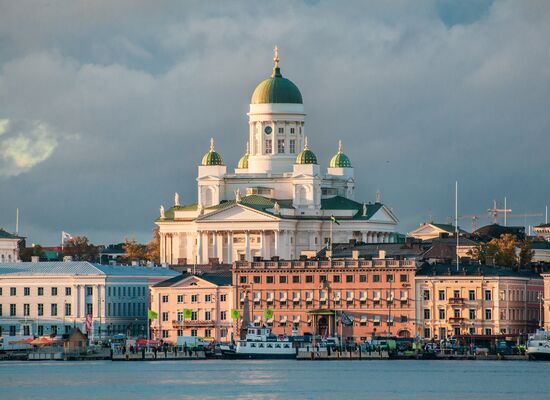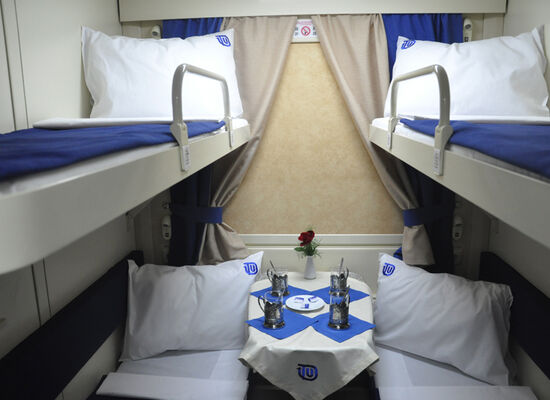Helsinki to Moscow Trains
Take a train journey from Finland to Russia
Helsinki to Moscow Train Route
Helsinki to Moscow train makes 7 stops on the way - in Tikkurila, Lahti, Kouvola, Vainikkala, Vyborg, St. Petersburg, and Tver. The trip takes 13 hours.
There is only one train running on the Helsinki to Moscow route - an overnight Lev Tolstoy train, which operates every day. The same train runs on the Moscow to Helsinki route.
Helsinki to Moscow Trains
based on 76 customer reviews
Frequently Asked Questions From Our Travelers
It takes 15 hours to cover the distance between Helsinki and Moscow by train.
In Moscow, the Leo Tolstoy arrives and departs Leningradsky Train Station, located at Komsomolskaya Ploshad 3, Metro Komsomolskaya. In Helsinki, the Leo Tolstoy arrives and departs from Helsinki Central Station, Kaivokatu 1.
There are 3 ticket types available on the Leo Tolstoy. VIP 1st class cabins are designed for 2 passengers, they feature a private shower and WC. There is one lower and one upper sleeping berth. Regular 1st class cabins are for two people, there are two lower berths and a fold-out table. 2nd class cabins are for four passengers, there are two lower and two upper berths.
Yes, there is a 30% discount for kids under the age of 10.
No, you should get a Russian visa in advance from the Russian Consulate in your country.
Yes, each car has a shower.
Yes, The Tolstoy train has a restaurant car. Also, you can buy coffee, tea and snacks from the train conductor in your car.
The Leo Tolstoy is a daily overnight train.
Testimonials
“
Smooth way to go to Moscow
Helsinki - Moscow on first class. I can highly recommend to approach Moscow by train from Helsinki. Excellent boarding and on-board service. Enjoy the view and share food and drinks while you ride towards this great metropolis.Next time I will do exactly the same !
“
Excellent experience - MUCH better than flying!
We took a train from Helsinki & St. Petersburg - Moscow round trip. Easy to book online (we did it from Portland, Oregon USA. The service was great, on time and organized. We had print-outs of our tickets from home, but didn't use them as everything was done with our passport.
History of the Helsinki to Moscow train route
The railway connection from Helsinki to Moscow is fairly modern, dating back to the 1950s. But the story of the railway between Helsinki and St Petersburg is much older – predating even the birth of Finland as an independent country – and much more eventful.
In March 1856, Tsar Alexander II decided to develop the railway system between Russia and the Grand Duchy of Finland, as the freezing winters and months of slushy thaws made road and waterway transport very difficult. Finland’s very first railway was founded in 1857, connecting Helsinki and the important Finnish city of Hämeenlinna, and a route between St Petersburg, Vyborg and Helsinki was later surveyed.
A disastrous crop failure in the 1860s caused a famine among the Finnish population and loss of income for the local government, so any hopes for railway construction were dashed. However, in 1867 Alexander II ordered for the railway construction to continue. In theory, this would create work for the hungry Finnish population, and Russia would help finance construction to take the burden off the local authorities. But in reality, mass migration in search of seasonal work led to disease epidemics, starvation, and hostility to destitute migrants. The mortality rate was so high in some places that the St Petersburg-Helsinki railway was dubbed “the road on bones”.
The railway finally opened on 11th September 1870, the name day of Tsar Alexander II. Finlyandsky Railway Station in St Petersburg was opened earlier that year, and included a special pavilion for the imperial family to use before travelling to Finland in their bespoke imperial train.
Did you know? Finlyandsky Railway Station is most famous for the arrival of Vladimir Lenin after his exile in Zurich. He was greeted here by a jubilant crowd and went on to start the October Revolution. The station also played a hugely important role during the Siege of Leningrad – it was the only station in the city which remained open and could receive supplies from the outside world.
The completion of the Helsinki to St Petersburg railway allowed Russians and Finns to easily visit each other’s capitals for the first time, and made a great economic contribution – in particular, the export of butter, timber and game to St Petersburg, where it was commonly sold at Sennaya Square market.
Did you know? The first restaurant cars on the St Petersburg-Helsinki railway were introduced in 1912. They were run by a French company called the ‘Compagnie Internationale’ and offered passengers an international menu served on fine china on crisp white tablecloths.
After the October Revolution Finland finally declared its sovereignty from Russia, but the troubles didn’t end there. Towns along the Helsinki to St. Petersburg railway became warzones during the post-revolutionary Civil War, and although the Bolsheviks initially captured the railway and Helsinki itself, they were finally pushed out by May 1918 and Finland remained independent.
The Helsinki to Moscow train service was finally founded in 1954. With passenger traffic between Moscow, Leningrad and Helsinki in full swing by the 1960s, Finnish tourists began flocking to the USSR by train as hotels, food and alcohol were much cheaper across the border.
Did you know? While most Finnish tourists were well behaved, a small but disruptive minority - known as ‘vodka tourists’ - caused genuine disturbances on their drunken trips to the USSR, especially in Leningrad. They vandalised, started fights, got sent to Soviet labour camps, and died at a rate of 2-3 per month due to alcohol consumption. Their antics even led the Soviet Consulate to suggest that visiting Finns be banned from buying alcohol.
The first branded Finland to Russia trains were launched in the 1970s, and in 1982 it was decided to name these two trains after outstanding Russian cultural figures – Lev Tolstoy and Ilya Repin. A third train was launched in 1992 and named after Finnish composer Jan Sibelius.
To this day, the Lev Tolstoy train serves the overnight Moscow and Helsinki train route, although the Ilya Repin and Jan Sibelius trains were replaced in 2010 with the high-speed Allegro train. Being able to travel with such ease between the two countries, in pre-covid times the vast majority of tourists in Finland were Russians, and Finns visited St Petersburg almost as much as they did Stockholm or Tallinn.
What to see on the Helsinki to Moscow railway route
Other than the obvious destinations of Moscow, St Petersburg and Helsinki, we would highly recommend a visit to Vyborg. Situated close to the Russian-Finnish border, Vyborg changed hands numerous times during its 800-year history and became part of Russia in 1944. The town’s tumultuous history is reflected in its unique atmosphere and cityscape, a mix of medieval Swedish architecture, elegant Northern Art Nouveau and grey Soviet blocks. Among Vyborg’s attractions are the 13th-century Vyborg Castle; the dilapidated cobbled streets and cosy cafés of the Old Town; and the 18th century Mon Repos Park, one of Eastern Europe’s largest English landscape gardens, characterised by its granite cliffs, bleakly beautiful Vyborg Bay waterfront, and romantic pavilions.
Once you have your tickets, look forward to a wonderful, smooth
and enjoyable journey through the Russian countryside.
Buy your ticket safely and securely and then sit back
and enjoy the ride!
Recommended by
Our travel group under the names Express to Russia, Russian Rail and Trans-Europe Express has been recommended and/or accredited by:

A portion of your order goes to helping underprivileged Russian children.












